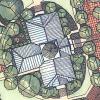Getting Downtown by Bike

Photo Credit: Jack Crowley
The vitality of a great downtown depends heavily on both its attraction and its accommodation of people. One of the principal elements of accommodation is getting to and from downtown easily and pleasantly. The more ways one can get there, the better. For the most part, for the past 60 years, it's been by car, with a sprinkle or two of buses and bicycles.
The Athens Downtown Master Plan proposes to greatly expand transportation access by adding or at least enhancing choices. One of the most viable and practical choices is the bicycle. It's certainly as close to a sustainable form of transportation as you can get, because its power is always directly provided by its rider.
This column is about the plan's proposals focusing on the bicycle. It is most important that all of us see bicycling as a true option for commuting. If creating bike lanes and separate bike corridors is to compete effectively for limited transportation funds with roads and highways, bikes must be seen as a realistic alternative form of getting around. In fact, building a comprehensive system of commuter bicycle corridors can significantly reduce a growing need to develop the more expensive alternatives of widening highways and erecting parking garages.
Bicycle trails, rather than corridors, are more closely related to recreation, which can be viewed as less important or less critical when funds are limited. Recreation and community health are the byproducts or beneficiaries of a well developed bicycle commuter corridor system. Likewise, such a system serves the pedestrian both in commuting to a lesser extent and recreating to a larger extent.
In the case of Athens, commuting downtown includes events and entertainment, government services, employment, shopping and a very large educational and research institution. With a well planned and built network, the bicycle "commuter shed" of five miles is easily served and potentially eliminates thousands of daily auto trips. This leaves roadway and parking capacities for those traveling from greater distances.
The proposed bicycle corridor system shown in the Downtown Master Plan is one built out in phases over a 15–18 year period. Successful earlier phases will likely create pressure to accelerate later phases. Athens' demographics and the availability of bridges, trestles and railroad beds to build a relatively flat system points to a very high potential for the corridors to be heavily used.
Based on input from the bicycling community, the system is designed to get the bicyclist to and from the edges of the downtown core and not inside it, where local auto traffic and cyclists assume similar speeds. In fact, the bicycle becomes the superior vehicle for navigating and parking downtown.
The map shows the fully developed proposed bicycle commuter corridor network.
The Firefly Trail Corridor Phase I picks up where the SPLOST project ends in Dudley Park and develops a trestle over Trail Creek (the Murmur Trestle) to an intersection with East Broad Street. It also recommends a third trestle or bridge connecting the east end of the Trail Creek trestle over Oak Street to Carr's Hill adjacent to Oconee Street United Methodist Church. Carr's Hill is a commuter shed where thousands of students, as well as others, live only a short but hilly distance from Athens' center and the University of Georgia.
The Firefly Corridor Phase II parallels the east side of Hickory Street before bridging over it into the embankment south of Whistleberry Apartments. The pathway then passes under the railroad (ideally after it is purchased) to connect with the east end of Dougherty at Foundry Street.
The Firefly Corridor Phase III is developed to parallel the west side of the railroad, passing behind the Standard development, crossing over North Avenue on a bridge paralleling the rail bridge to the north side of Lay Park, where it intersects with the Jackson Street corridor.
The Firefly Corridor Phase IV extends the commuter pathway westward, paralleling the CSX railroad crossing over College Avenue and connecting with the Pulaski Greenway and Pulaski Street. To keep the corridor in a relatively flat configuration, it should employ a trestle over the Pulaski Greenway.
The Pulaski Greenway extended southward to Dougherty provides a bike corridor connection to the northwest corner of downtown.
The final link to Boulevard and other west Athens neighborhoods requires additional study and falls outside the edge of the Downtown Master Plan. This is a very important final segment that a preliminary study shows could pass along the south edge of the Leathers Building, go through the Pulaski Heights residential area on undeveloped lots, cross over a drainage area and pass through the new park on Barber Street to Boulevard. Boulevard's width is particularly suitable for wide, designated bike lanes.
The bikeway extending through the entire UGA campus and connecting to downtown at East Broad Street will require acquisition of the Norfolk and Southern railroad right-of-way for development of campus light rail. The light rail and commuter bikeway would be compatible when designed correctly.
The Pulaski Extension is a street project with a wide bicycle corridor along its east side. Extended southward to Baxter Street, it connects the central UGA campus, the new Terry College complex, the special collections library and the dorms on Baxter Hill to the west edge of downtown.
Keywords
More by Jack Crowley
-

How to Fix Up the Costa Building
Downtown Master Plan
-

What We Should Do With the Old Jittery Joe's Roaster Building
Downtown Master Plan
-

What Downtown Development Should Look Like
News Feature









comments